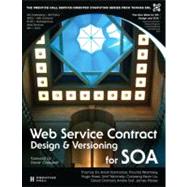
What is included with this book?
Thomas Erl is the world’s top-selling SOA author, Series Editor of the Prentice Hall Service-Oriented Computing Series from Thomas Erl, and Editor of the SOA Magazine (www.soamag.com). With over 100,000 copies in print world-wide, his books have become international bestsellers and have been formally endorsed by senior members of major software organizations, such as IBM, Microsoft, Oracle, BEA, Sun, Intel, SAP, and HP.
His most recent titles SOA Design Patterns (www.soapatterns.com) and Web Service Contract Design and Versioning for SOA were co-authored with a series of industry experts and follow his first three books Service-Oriented Architecture: A Field Guide to Integrating XML and Web Services, Service-Oriented Architecture: Concepts , Technology , and Design, and SOA: Principles of Service Design (www.soaprinciples.com). Thomas is the founder of SOA Systems Inc. (www.soasystems.com), a company specializing in SOA consulting and training services with a vendor-agnostic focus. Thomas is also the founder of the internationally recognized SOA Certified Professional program (www.soacp.com and www.soaschool.com). Thomas is a speaker and instructor for private and public events, and has delivered many workshops and keynote speeches. Articles and interviews by Thomas have been published in numerous publications, including The Wall Street Journal.
For more information, visit: www.thomaserl.com.
| Foreword | p. xxxv |
| Preface | p. xxxvii |
| Introduction | p. 1 |
| Case Study Background | p. 17 |
| Fundamental Service Contract Design | p. 21 |
| SOA Fundamentals and Web Service Contracts | p. 23 |
| Anatomy of a Web Service Contract | p. 49 |
| A Plain English Guide to Namespaces | p. 81 |
| Fundamental XML Schema: Types and Message Structure Basics | p. 117 |
| Fundamental WSDL | |
| Abstract Description Design | p. 167 |
| Fundamental WSDL | |
| Concrete Description Design | p. 197 |
| Fundamental WSDL 2.0: New Features and Design Options | p. 225 |
| Fundamental WS-Policy: Assertions, Expressions, and Attachments | p. 241 |
| Fundamental Message Design: SOAP Envelope Structure, Fault Messages, and Header Processing | p. 271 |
| Advanced Service Contract Design | p. 307 |
| Advanced XML Schema | |
| Message Flexibility, Type Inheritance, and Composition | p. 309 |
| Advanced XML Schema | |
| Reusability, Relational Design, and Industry Schemas | p. 353 |
| Advanced WSDL | |
| Modularization, Extensibility, MEPs, and Asynchrony | p. 395 |
| Advanced WSDL | |
| Message Dispatch, Service Instance Identification, and Non-SOAP HTTP Binding | p. 445 |
| Advanced WS-Policy | |
| Policy Centralization and Nested, Parameterized, and Ignorable Assertions | p. 485 |
| Advanced WS-Policy | |
| Custom Policy Assertion Design, Runtime Representation, and Compatibility | p. 517 |
| Advanced Message Design | |
| WS-Addressing Vocabularies | p. 549 |
| Advanced Message Design | |
| WS-Addressing Rules and Design Techniques | p. 569 |
| Service Contract Versioning | p. 597 |
| Versioning Fundamentals | p. 599 |
| Versioning WSDL Definitions | p. 617 |
| Versioning Message Schemas | p. 657 |
| Advanced Versioning | p. 689 |
| Appendices | p. 719 |
| Case Study Conclusion | p. 721 |
| How Technology Standards are Developed | p. 725 |
| Alphabetical Pseudo Schema Reference | p. 729 |
| Namespaces and Prefixes Used in this Book | p. 747 |
| SOA Design Patterns Related to this Book | p. 751 |
| About the Authors | p. 763 |
| Index | p. 769 |
| Table of Contents provided by Publisher. All Rights Reserved. |
The New copy of this book will include any supplemental materials advertised. Please check the title of the book to determine if it should include any access cards, study guides, lab manuals, CDs, etc.
The Used, Rental and eBook copies of this book are not guaranteed to include any supplemental materials. Typically, only the book itself is included. This is true even if the title states it includes any access cards, study guides, lab manuals, CDs, etc.